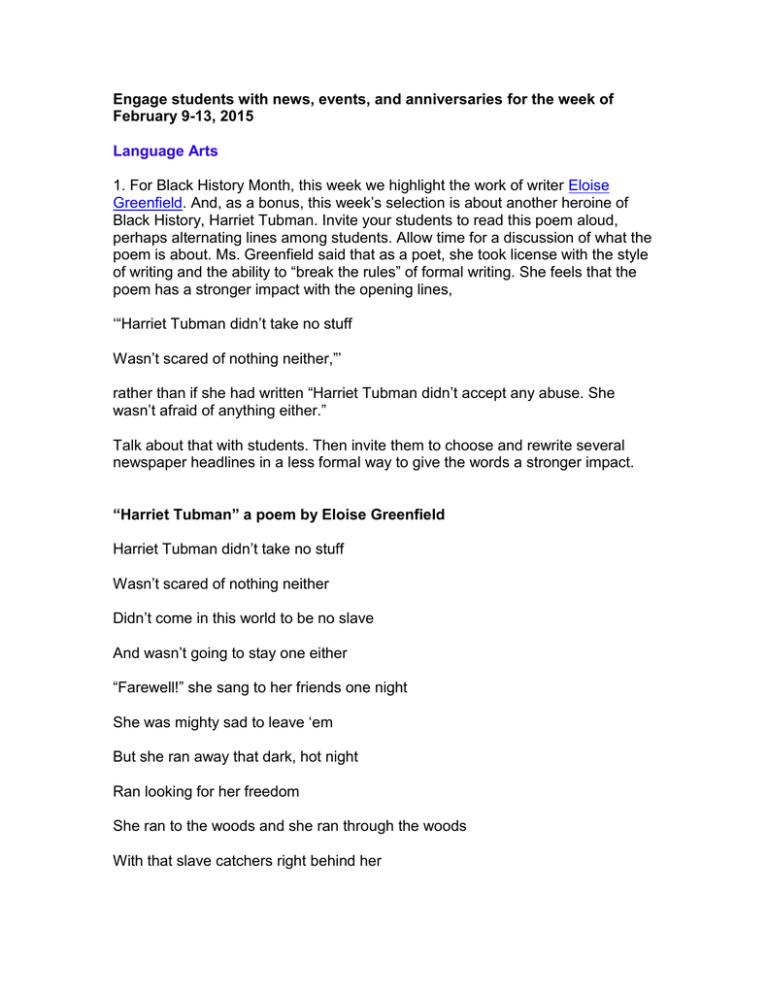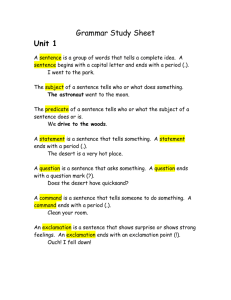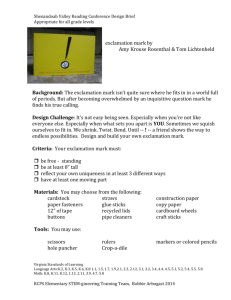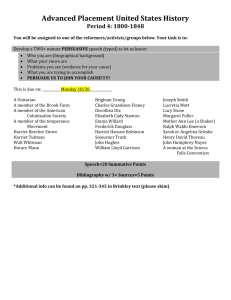HSPA47 - HSPA Foundation
advertisement

Engage students with news, events, and anniversaries for the week of February 9-13, 2015 Language Arts 1. For Black History Month, this week we highlight the work of writer Eloise Greenfield. And, as a bonus, this week’s selection is about another heroine of Black History, Harriet Tubman. Invite your students to read this poem aloud, perhaps alternating lines among students. Allow time for a discussion of what the poem is about. Ms. Greenfield said that as a poet, she took license with the style of writing and the ability to “break the rules” of formal writing. She feels that the poem has a stronger impact with the opening lines, ‘“Harriet Tubman didn’t take no stuff Wasn’t scared of nothing neither,”’ rather than if she had written “Harriet Tubman didn’t accept any abuse. She wasn’t afraid of anything either.” Talk about that with students. Then invite them to choose and rewrite several newspaper headlines in a less formal way to give the words a stronger impact. “Harriet Tubman” a poem by Eloise Greenfield Harriet Tubman didn’t take no stuff Wasn’t scared of nothing neither Didn’t come in this world to be no slave And wasn’t going to stay one either “Farewell!” she sang to her friends one night She was mighty sad to leave ‘em But she ran away that dark, hot night Ran looking for her freedom She ran to the woods and she ran through the woods With that slave catchers right behind her And she kept on going till she got to the North Where those mean men couldn’t find her Nineteen times she went back South To get three hundred others She ran for her freedom nineteen times To save Black sisters and brothers Harriet Tubman didn’t take no stuff Wasn’t scared of nothing neither Didn’t come into this world to be no slave And didn’t stay one either And didn’t stay one either Indiana Academic Standard: Determine the meaning of words and phrases as they are used in works of literature, including figurative and connotative meanings; analyze the impact of a specific word choice on meaning and tone 2. This lesson teaches students argument mapping. This activity is terrific for helping students build an “argument” with supporting details. Assign them to choose an issue from today’s news to debate. They should draw facts and details from the news to support their side. Indiana Academic Standard: Determine how a theme or central idea of a work of literature is conveyed through particular details; provide a detailed, objective summary of the text. 3. Invite students to “put your pet on a jet.” Have them choose any pet, it could be their real pet or one they’d like to have. They can look though the newspaper for a place the pet could visit. It can be a local place or one far away. They should take facts about the place from the newspaper story and write a journal entry that the pet might write after visiting that place. You can have them create the journal, complete with pictures of the pet. Check out http://www.pics4learning.com for copyright-free (for education) pictures of animals that your students can use. Indiana Academic Standard: apply reading standards to support reflection and response to literature and nonfiction texts Math 1. Working with Roman Numerals? Here’s a good practice activity, based on data your students can find in the newspaper. Begin by explaining or reminding students that the numbers we use are called Arabic numerals. They were likely created by Indian mathematicians and later used by Arab mathematicians and then by those in Europe. Romans used what we call Roman numerals. Have students use the weather information to find a list of temperatures across the country. They can pick ten cities and put them in order from coldest to warmest. Then, have them rewrite each temperature in Roman Numerals. There’s a cool online tool they can use to check their work, too. Click here for a site that converts Arabic to Roman numerals. Indiana Academic Standard: Read and write whole numbers up to 1,000,000. Use words, models, standard form and expanded form to represent and show equivalent forms of whole numbers up to 1,000,000 2. Here’s a great way to have students practice estimation. The mission is to estimate how many words are in the lead story on the front page. Before they begin, have them brainstorm methods they could use to get the most accurate estimation. Utilizing one of the methods discussed, have them estimate. You may want to create a graph showing the guesses of everyone in the class. Then assign several students to do an exact count of the words to see which estimation method worked best. Indiana Academic Standard: Solve real-world problems involving addition and subtraction of multi-digit whole numbers (e.g., by using drawings and equations with a symbol for the unknown number to represent the problem). Science Literacy 1. It may be interesting to have students look through the Business section of related stories to find an example of a business development that could have an impact on the environment. Have them write an essay for or against the development based on its environmental impact. Indiana Academic Standard: Cite specific textual evidence to support analysis of science and technical texts These days your students might hear the word “organic” quite a bit. They might not be as familiar with its antonym, “synthetic.” Although the differences are complex, put simply, organic means something that is derived from nature while synthetic means something that is human-made. Assign students to find five examples of each in the newspaper. Which is easier to find? Why? Indiana Academic Standard: Distinguish among facts, reasoned judgment based on research findings, and speculation in a text Social Studies 1.Valentine’s Day has a rich and interesting history. Invite students to click here to learn more about it. Then, send them into the newspaper to identify a story about love. They should summarize the story and write a definition of love based on the main ideas of the article they chose. Indiana Academic Standard: Cite textual evidence to support analysis of what a text says explicitly as well as inferences drawn from the text. 2. Explain to students that on February 9, 1861, Jefferson Davis was chosen to be president of the Confederate States of America. That was a group of seven states-- Alabama, Florida, Georgia, Louisiana, Mississippi, South Carolina, and Texas-- that had seceded or separated from the United States of America. As your students know, that Confederacy ceased to exist with the end of the Civil War in 1865. Ask students to think about how today’s newspaper might be different if the Confederacy still existed. Which stories do they think they wouldn’t see? They should choose two and write about why they wouldn’t exist if America had split in two permanently. Indiana Academic Standard: Integrate information presented in different media or formats (e.g., visually, quantitatively, verbally) to demonstrate a coherent understanding of a topic or issue 3. On February 10, 1897, The New York Times newspaper began using a slogan, “All the News That’s Fit to Print.” What do your students think that means? Is there any news in the newspaper that they don’t think is “fit to print?” Have them find out if your local newspaper has a slogan and compare and contrast the two. Indiana Academic Standard: Critically analyze information found in electronic, print, and mass media used to inform, persuade, entertain, and transmit culture Write the News Lesson Topic: Stop!!!! Exclamation marks or points (!) are used when a writer wants to show strong feelings. Similar to using ALL CAPS when texting or messaging, exclamation points are like shouting when you speak. They are rarely used in newspapers because they are more appropriate for informal writing. It’s fine to use them when writing friendly e-mails, letters, texts, or tweets. When trying to use fewer words, it’s okay to rely on punctuation to express feeling. But, in more formal writing, exclamation points may be a lazy way to describe emotion. Writer F. Scott Fitzgerald said, “Cut out all these exclamation points. An exclamation point is like laughing at your own joke.” Author Elmore Leonard wrote, “You are allowed no more than two or three per 100,000 words of prose.” That means about one per novel. Why were these talented writers so down on this punctuation mark? Perhaps it is because they knew that good writers “show” rather than “tell.” They use words to convey meaning rather than count on the punctuation to do the job. And overuse of the exclamation mark cuts down on its meaning and its impact. Look carefully to see if you can find any exclamation marks in today’s newspaper. If you find one, see if you can figure out why it was used. Rewrite each of these sentences, replacing the exclamation marks with words that convey the meaning intended. Use “muscular” language with strong verbs and nouns. I was rejected from the college I wanted to attend! Don’t use too many exclamation points!! There was an accident!







